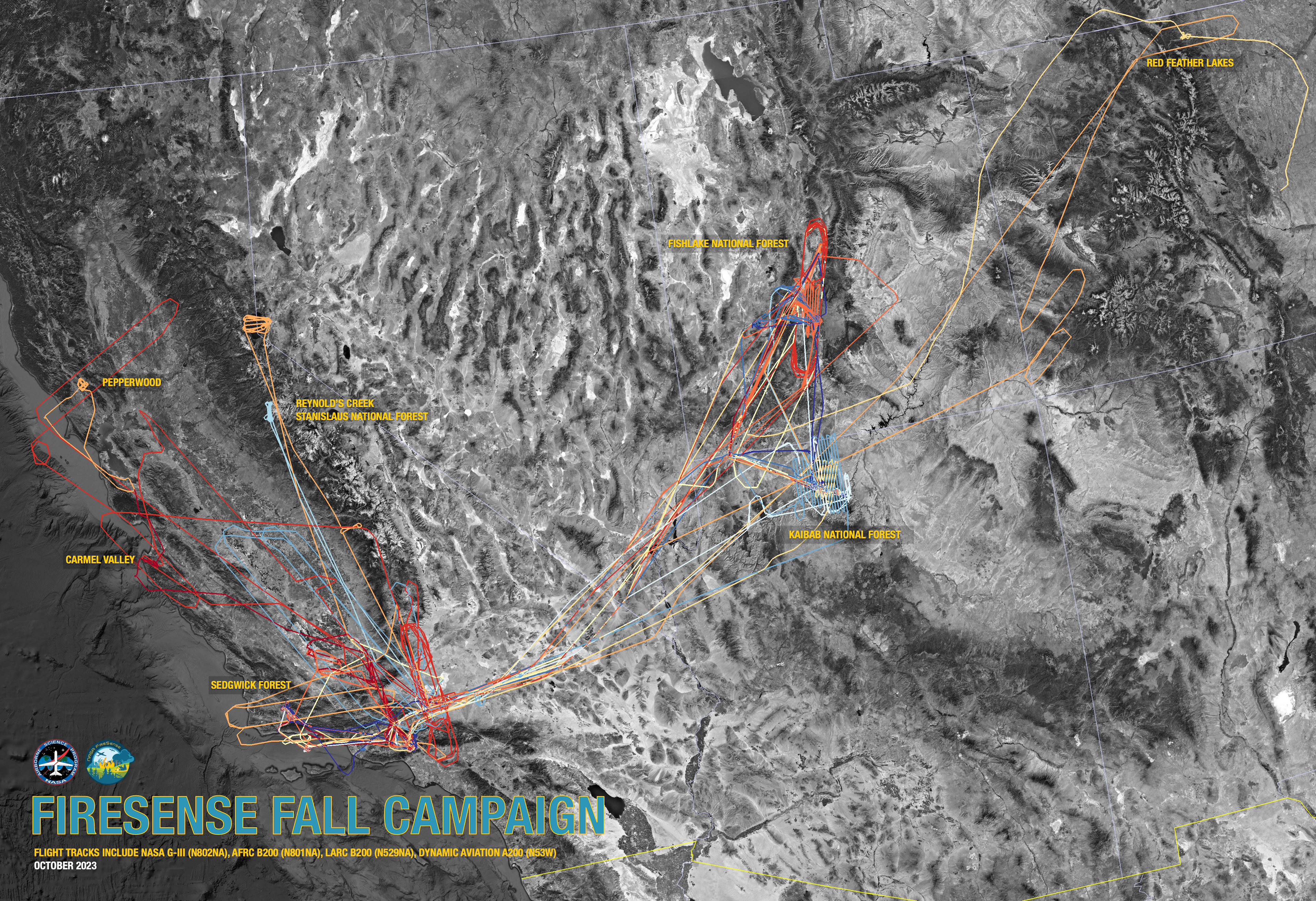NASA’s FireSense Project conducts airborne observations over wildland fires and prescription burn areas to evaluate and test new instrumentation and collect both remotely-sensed and in situ data that can inform management decisions and improve fire models.
The FireSense project is focused on four uses-cases to improve wildfire management. These include the measurement of pre-fire fuels conditions, active fire dynamics, post fire impacts and threats, as well as air quality
forecasting, each co-developed with identified wildfire management agency stakeholders. FireSense has a recurring airborne component where the project tests and further develops capabilities and technologies for transfer
to stakeholders. A larger airborne campaign will take place during year five of the project (2027-2028) to fully demonstrate the technology developed during FireSense.
Data from the FireSense campaigns will be stored in a
FireSense data repository
developed by FireSense Implementation Team members at NASA
Langley. The platform supports storage for documents, text
delimited files (csv), geospatial data (point/polygon,
geotiff, netcdf, laz,), as well as providing password
protection on a government system. This is the same data
system that supports other NASA airborne campaigns,
including the FIREX-AQ project.
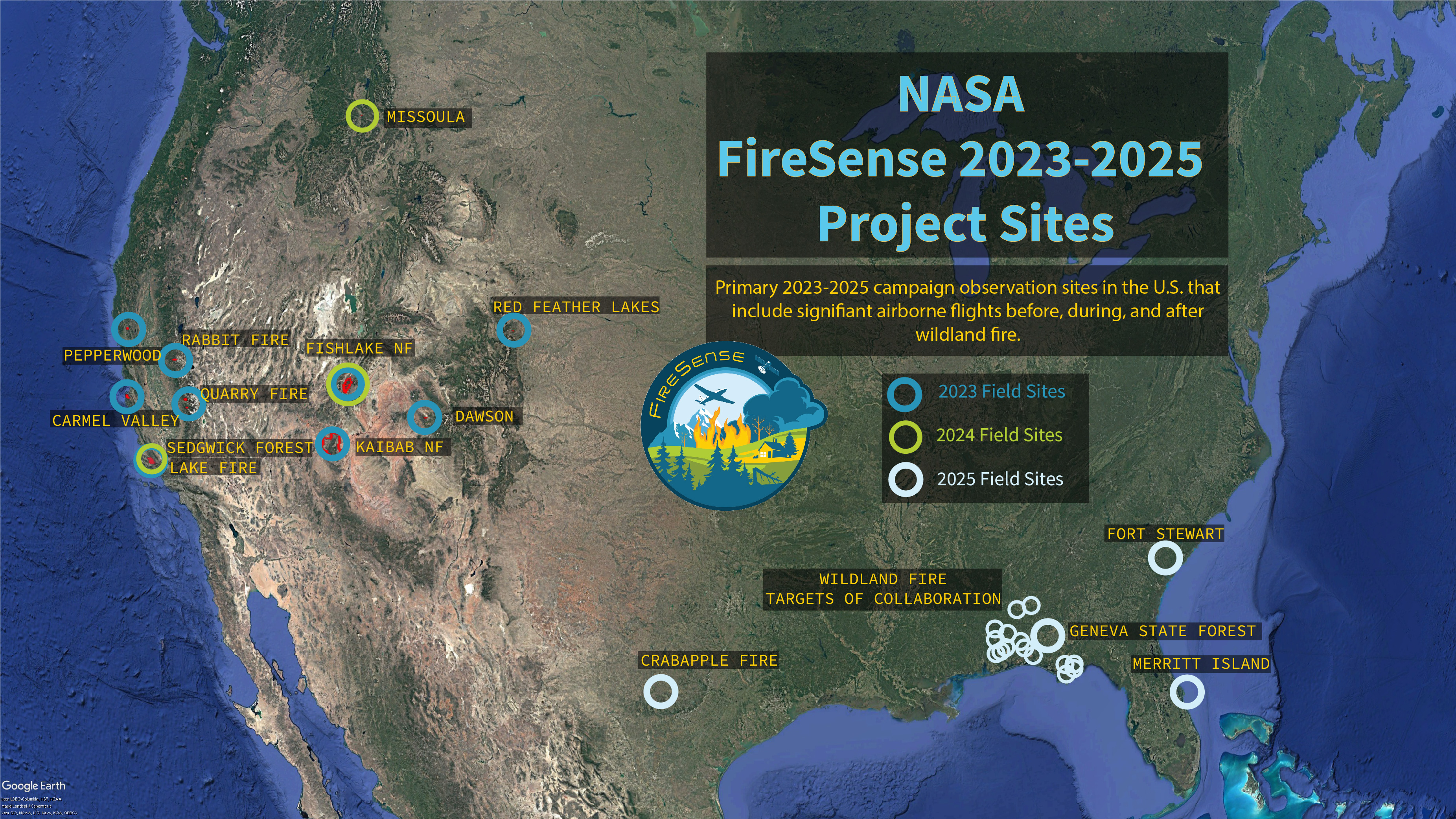
In 2025 FireSense campaign activities occurred in the southeastern United States, specifically Geneva State Forest in Alabama, Merritt Island National Wildlife Refuge in Florida, and Fort Stewart in Georgia, as well as surrounding states including TX, MS and OK. Primary objectives include demonstration and evaluation of technology to support wildland fire management decisions and collection of measurements to validate prediction models for wildland fire and smoke management.
The aircraft, UAVs, and instruments used were:
Data from the FireSense campaigns will be stored in a
FireSense data repository.
Airborne Visible/Infrared Imaging Spectrometer 3 (AVIRIS-3)
- Visible and Short-Wave Infrared (VIS-SWIR)
- Vegetation Composition, Fire Behavior, Fire Effects
MODIS/ASTER Airborne Simulator (MASTER)
- Visible, Mid-Wave Infrared, Thermal Infrared (VIS-MWIR-TIR)
- Fire Radiative Power
UAV Based Data Collection
- LiDAR, Meteorological, Infrared Sensors
- 3D Elevation, temperature, atmospheric pressure, relative humidity, wind speed and direction
- Vegetation structure, fire behavior, atmospheric conditions, and wind profiles
Tactical Fire Remote Sensing (TACFI-RS)
- Time Based Fire location and intensity
- Fire behavior characteristics
Fire Thermal Infrared Imaging System (FireTIRS)
- Multispectral thermal infrared sensor
- Fire behavior characterization,
- Trace gasses, thermal fluxes
Fuel and Soil Sampling
- Temperature and moisture
- Fuel load
- Post-fire soil burn severity and ash
Rapidly Deployable Atmospheric Profiling System (RaDAPS)
- Wind profiler, lidar ceilometer, Rain Radar, Doppler sodar, parsivel disdrometer, microwave profiling radiometer
- Boundary layer, aerosol, and cloud characteristics. Temperature, relative humidity, precipitation, atmospheric pressure, and wind profiles.
Mobile Operated Doppler Lidar System (MoDLS)
- Doppler Wind LiDAR, radiosondes, surface measurements
- Surface meteorology; wind measurements and temperature
The FireSense Spring 2025 Campaign occurred in two phases with Phase I occurring between March 17-28 2025, and Phase II occurring April 12-20, 2025.
Phase I included data collection over “targets of collaboration,”
such as wildland fires in Florida, Alabama, Mississippi, Texas, and Oklahoma as well as a coordinated prescribed fire research activity in southern Alabama.
Phase II included a series of flights over prescribed
fires at Fort Stewart Hunter Army airfield, select targets of collaboration, and pre- and post-fire flights over Merritt Island National Wildlife Refuge.
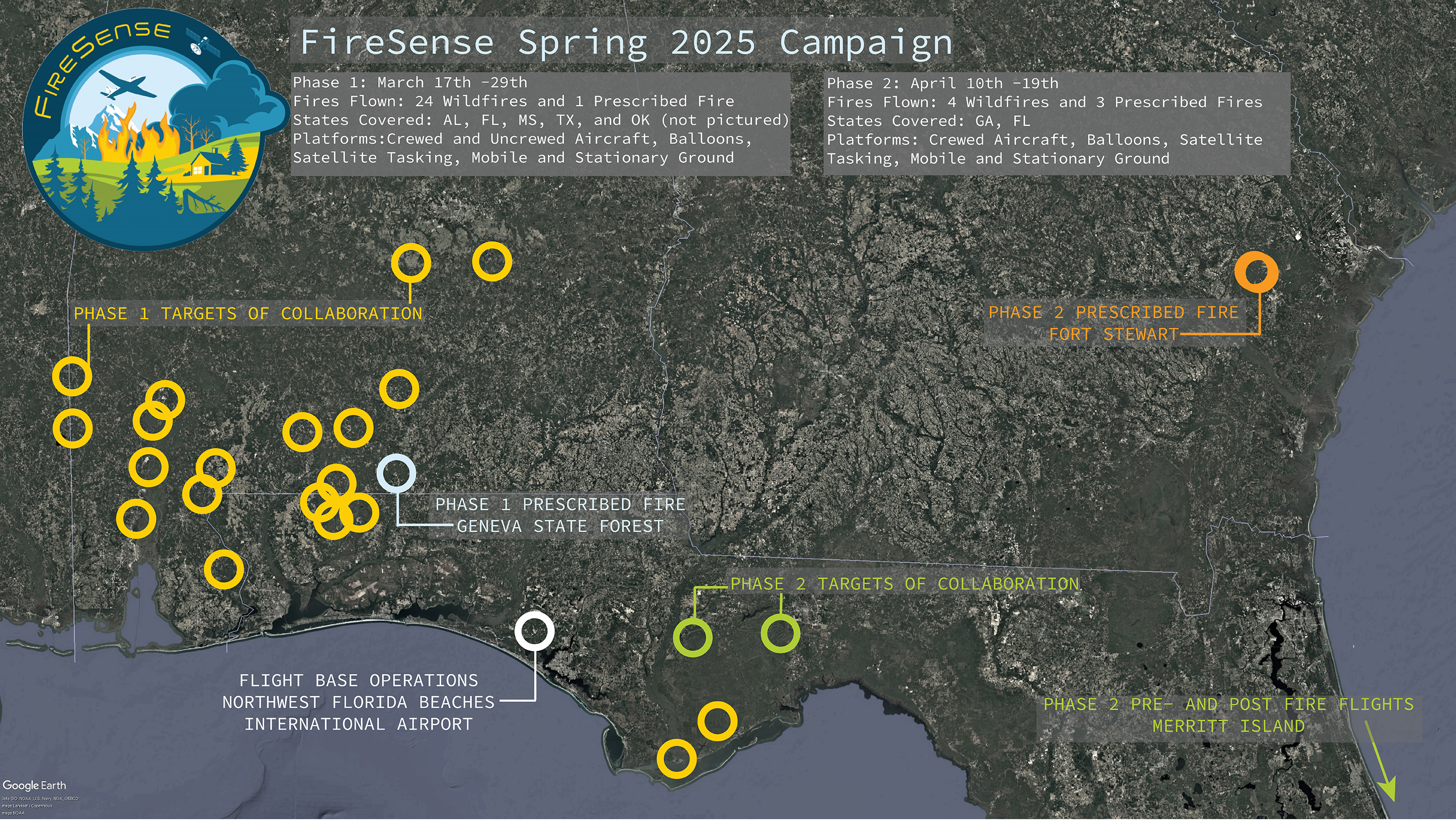
- Alabama Forestry Commission
- National Interagency Fire Center Incident Awareness and Assessment (IAA) Group
- Department of Defense, Strategic Environmental Research and Development Program (SERDP) and the Environmental Security Technology Certification Program (ESTCP)
- US Forest Service
During 2024, one aircraft and multiple
unmanned aerial vehicles (UAVs) were deployed
and equipped with passive and active remote
sensing instruments to sample vegetation
structure, fire behavior and effects,
atmospheric conditions, and areas affected by
wildland and prescribed fires in the Western
United States.
The aircraft, UAVs, and instruments used were:
Data from the FireSense campaigns will be
stored in a
FireSense data repository.
Expected data products and potential use are
listed. Some additional data products will be
added.
-
Visible and Short-Wave Infrared (VIS-SWIR)
-
Vegetation Composition, Fire Behavior,
Fire Effects
UAV Based Data Collection
-
LiDAR, Meteorological, Infrared Sensors
-
3D Elevation, temperature, atmospheric
pressure, relative humidity, wind speed
and direction
-
Vegetation structure, atmospheric
conditions, and wind profiles
Observation sites included in 2024 FireSense campaign activities that focused on air quality and atmospheric measurements, as well as post-fire airborne data collection.
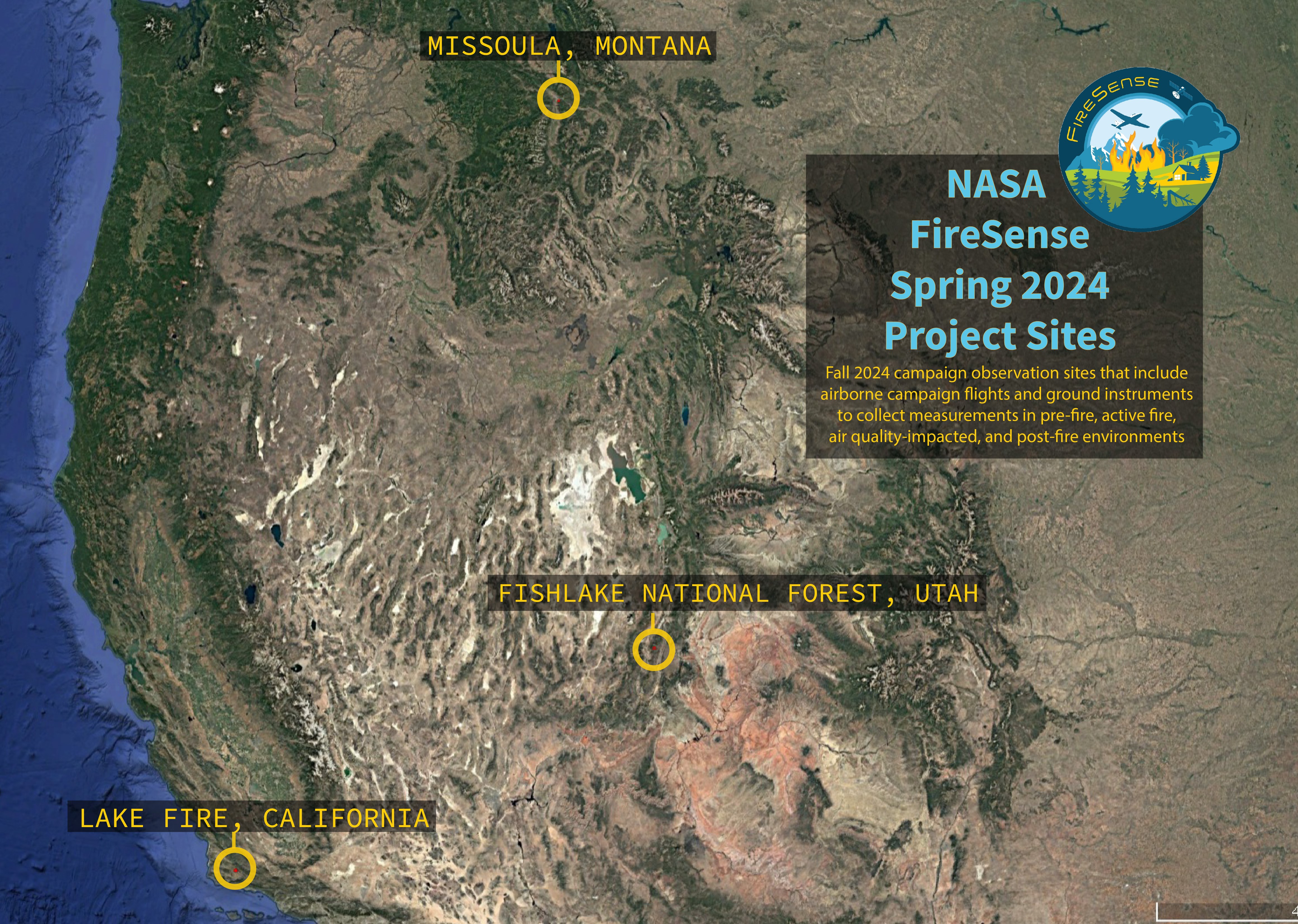
The Fall 2024 campaign observation site in Missoula, Montana, that included atmospheric soundings and data collection within a smoke-impacted airshed.
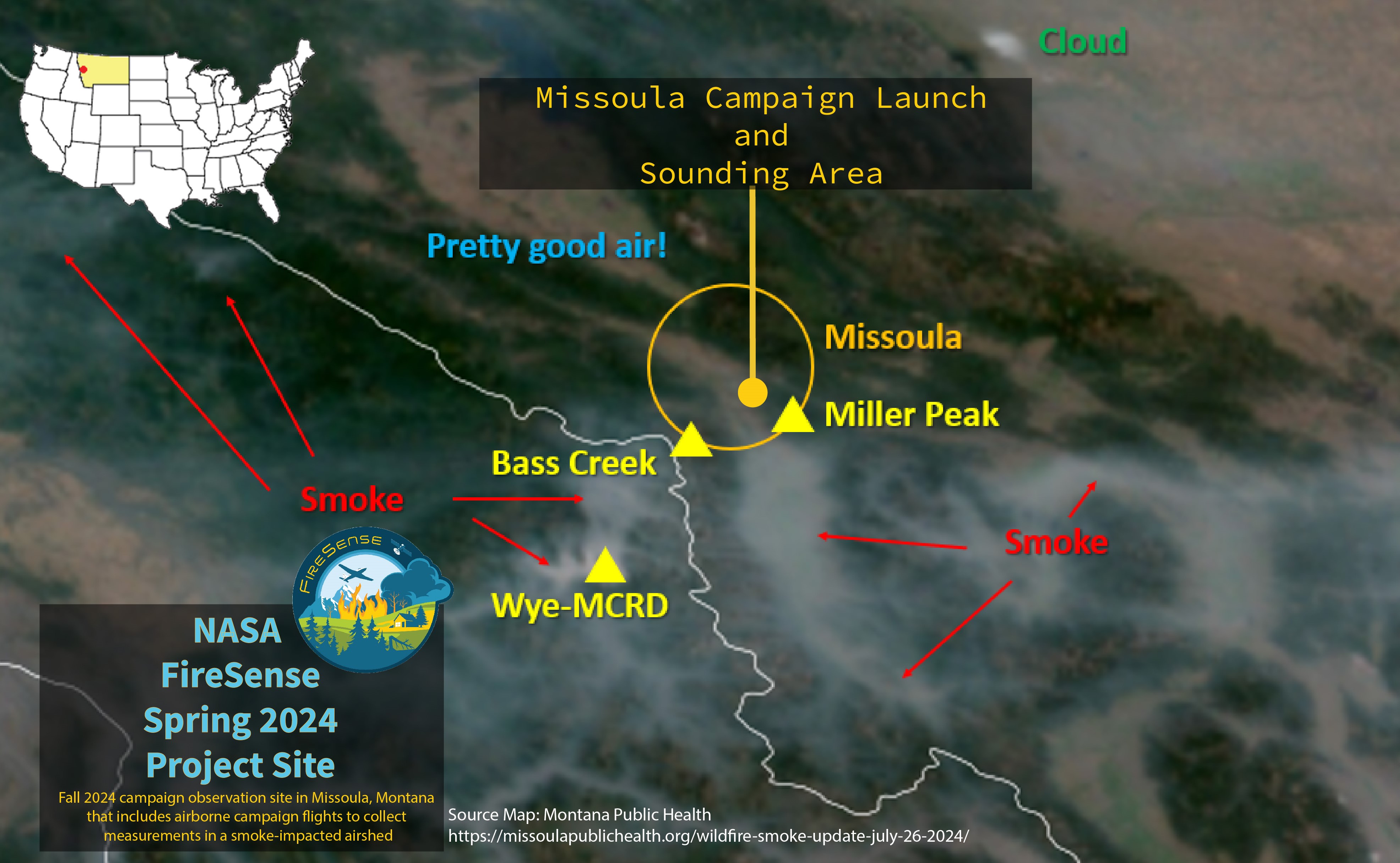
- MITRE
- ESRI
- University of Montana
- US Forest Service
- National Oceanic and Atmospheric Administration
During the fall 2023 deployment, four aircraft
were deployed and equipped with active and
passive airborne remote sensing instruments to
sample vegetation, soil moisture and areas
affected by wildland and prescribed fires in
the western United States.
The aircraft and instruments included were:
Flight details for the 2023 campaign can be
found at the
ESPO FireSense website.
Data from the FireSense campaigns will be
stored in a
FireSense data repository.
Expected data products and potential use are
listed. Some additional data products will be
added.
-
Visible and Short-Wave Infrared (VIS-SWIR)
-
Vegetation Composition, Fire Behavior,
Fire Effects
-
Visible, Mid-Wave Infrared, Thermal
Infrared (VIS-MWIR-TIR)
- Fire Radiative Power
- L-Band Active Radar
-
Estimated moisture in vegetation, fuels
and soil
- L-Band Active & Passive Radar
-
Estimated moisture in fuels and soil
San Jose State University Wildfire Imaging
System (SWIS)
- Visible and Infrared Imagery
- Fire Dynamics, Radiative Power
B-200/C-20A Meteorological and Navigation
data
Field Reports
The 2023 campaign primary observation sites in
the Western U.S. include significant airborne
flights with complementary ground measurements
when possible.
